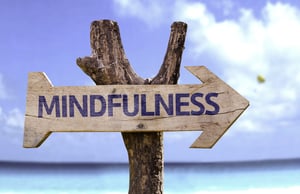What it takes to be a Great mindful IT Leader
Leadership is unlocking people's potential to become better. Read More
16 min czytania


For one, mindfulness is proven to help leaders manage to increase their focus, manage their emotions and improve their engagement, which reduces employee stress, creates a better workplace, and improves the bottom line.
In this section we will learn more about the why before we move on to the what and how.
And maybe before you even get started you would like to take a mindful minute and STOPP. Click here to practice it.
The big why is that mindfulness provides a way to understand and support the human central processing unit (CPU).
Studies to date suggest that mindfulness based programs give us the right map to navigate our inner workings and research is beginning to largely prove that mindfulness practices affects many aspects of our well-being—improving our mood, increasing positive emotions, and decreasing our anxiety, emotional reactivity, and job burnout.
Many organizations worldwide have implemented mindfulness programs so far, and this number is still rising. It suffices to mention Adobe, Aetna, Bosch, General Mills, Google, IBM, Intel, Nike, SAP, Target.
You can get free access to the Benefits of Mindfulness in the Workplace Report here.
Benefits include an increase the management of stress, an increase in engagement and increases in focus at work. We put together a special blog post just for you if you are interested in learned about how to increase the focus on your team(s). Would you believe that U.S. workers waste about 25 percent of their time dealing with “distractions," that nearly 3 out of 4 workers (70%) admit they feel distracted at work.
To learn more about distraction and focus you can click here to get a Free Copy of The Mindful Leader Distraction Report or you can read about the Top 3 Distractions during the workday and how to deal with them.
 People tend to lose some of their cognitive flexibility and short-term memory as they age. But mindfulness may be able to slow cognitive decline, even in people with Alzheimer’s disease according to some studies.
People tend to lose some of their cognitive flexibility and short-term memory as they age. But mindfulness may be able to slow cognitive decline, even in people with Alzheimer’s disease according to some studies.
Mindfulness studies show that mindfulness helps in calming our minds, thoughts and emotions. Some studies suggest that you may experience a sounder sleep, less anxiety and a more positive outlook on life.
Furthermore, studies show that mindfulness practices have greater benefit in the workplace, from the absorption of new information, to an increase in problem-solving and facilitating creativity, as well as an increased empathy for other employees.

The American Heart Association concluded that, while research remains preliminary, there is enough evidence to suggest mindfulness as an adjunct treatment for coronary disease and its prevention.
Mindfulness may also be good for hearts that are already relatively healthy. Research suggests that meditating can increase respiratory sinus arrhythmia, the natural variations in heart rate that happen when we breathe that indicate better heart health and an increased chance of surviving a heart attack.
 By practicing regularly, we can soothe our nerves and help our systems run as they should, rather than operate in a reflexive, stress-induced shutdown mode. If you are interested in 3 quick and basic techniques to perform better under pressure check out this blog.
By practicing regularly, we can soothe our nerves and help our systems run as they should, rather than operate in a reflexive, stress-induced shutdown mode. If you are interested in 3 quick and basic techniques to perform better under pressure check out this blog.
Some physical health benefits of certain mindfulness practices include:
Moreover, mindfulness helps us shift from automatic reactivity to responsiveness, and from avoidance patterns to a genuine willingness to meet present-moment experience as it is. And according to the research it helps increase our ability to focus. Learn more about focus, distraction and mindfulness here. Our ability to manage our emotions. And our ability to manage our thrive in the workplace.
And if you have time, then, well, to start it's important to start at the root. Mindfulness stems from two sources. One old and one new. When it comes to the old, mindfulness concepts and practices emerge in many contemplative practices around the globe. Ranging from Rational Philosophies in ancient Greece, to Daoism in China, Monotheism in the Middle East, Tribal Practices in the Americas and Africa to Hinduism on the Indian Sub-Continent. The period between 900-200 B.C.E was an era of great inter-culturally developed with scholars ranging from Socrates, to Confucius to Buddha. Two, when it comes to the new. Mindfulness grows out of insights of modern-day Psychology and Neuroscience
In the old, it was mostly used to understand the human mind, heart and body. And now modern psychology is taking it mainstage in the fields of understanding human suffering, well-being and prosperity. So what is it?
Perhaps the most often quoted definition of mindfulness is Jon Kabat-Zinn’s definition, “A way of being in a wise and purposeful relationship with one’s experience, both inwardly and outwardly. It is cultivated by systematically exercising one’s capacity for paying attention, on purpose, in the present moment and non-judgmentally.”

Or as the cognitive scientist John Teasdale has described the essence of mindfulness as full awareness of our experience in each moment, equally open to whatever it has to offer and free of the domination of habitual, automatic, cognitive routines that are often goal oriented and, in one form or another, related to wanting things to be other than they are (Teasdale & Chaskalson, 2011a, 2011b).
I also like Daniel Rechtschaffen, definition which adds more fun and open mindfulness, “Playing attention, on purpose, in the present moment and non-judgmentally.” You can find more great definitions on our "What it takes to be "Great Leader" blog.
Check out our Mindful Leader Podcast on Spotify

Disk defragmentation takes all the pieces of each file, and stores them in one place. It also makes sure programs are each in one place, and that unused space on the hard disk is all together. Being mindful allows us to observe the files (thoughts, emotions, sensations) and store them accordingly. Just like it is important to fragment your disk it is important to fragment the mind.

Simple being or awareness is compared to standing ontop of a tower, surveying the surrounding landscape. You are just watching, just seeing, no agenda. And in doing so we bring our attention and awareness intentionally, receptively, and in a relaxed manner. We thus, begin to understand a perspective that does not overly identify with the particulars of the terrain, this is the first step in dis-identifying or decentering - becoming more aware that you are not necessarily your thoughts, emotions and sensations.
As the watcher of this tower, your attention can be intentionally moved around, therefore, allowing your focus, size, and quality of the attention to be altered.
Think about it this way. If your thoughts are trains, then your mind is a train station through which all of these trains pass. With such a metaphor, your mind is a wide-open place with the potential to take you anywhere you want to go. And if you have been at a train station, especially, pre-covid, it’s also a chaotic place with lots going on, loud noises, crowds, movement, and plenty of information that isn't relevant for your travel. It’s easy to get lost, overwhelmed or both.

Image you are standing on a platform, and a thought arises (a train), it's very tempting and easy to take the first train of thought that arrives
Especially if habits have been formed. We simply take whichever train seems to pull into our mental train station first. We just hop on board the train that is front and center, without asking where is this train going to take me? Is this train even the train I want to be on?
Imagine that in a few minutes you leave the office, or go outside or you just simply look out the window. (Seriously though, go do this after you read this: )
You are looking up at the sky and the sun is shining (whether the clouds are blocking it is another story).
Watch the clouds or lack of clouds for a few minutes as they float through the sky. Pretend now (beginners mind here), you have a special power. Whatever arises within you, a thought, an emotion, a feeling, a story, a sensation, you can now take that thought or feeling and float it outside of yourself and place it in the sky on clouds, the wind, the sun, whatever you want.

Watch as the thought or feeling changes, morphs in the sky, and then eventually change, depart. Whenever another thought or feeling comes up, you continue to place it in the sky and watch it slowly change away. Continue to practice this for a few minutes. Perhaps, you can relate being mindful to being the sky, the thoughts, emotions, sensations and impulses are the weather. They change and morph in the midst of the sky. Your superpower is that you are like the sky, always like the sky, ever present. Ever here. Ever now.
Continue to let your thoughts and feelings float outside of you into the sky. After a few minutes, and when you feel ready, come back to the present moment and get back to work ;)
To find out more about what mindfulness is not, watch the series of videos below.
Otherwise just remember that:
1. Mindfulness is neither relaxation nor in the service of becoming relaxed.
2. Mindfulness is neither a quick fix nor simple.
3. Mindfulness is not about emptying the mind, not thinking, or turning away from experience.
4. Mindfulness is not about dismantling the self.
5. Mindfulness and meditation are not one and the same.
"Mindfulness practice can evoke a range of experiences that are unfamiliar, unknown, and even frightening. These include involuntary body movements, seeing lights or hearing sounds, states such as dissociation, or an exacerbation of anxiety or low mood. This is, of course, not the intention of mindfulness practice. It is imperative that mindfulness teachers are appropriately trained. In the same way that an engineer or a doctor should only undertake work they are qualified to do, mindfulness teachers need to be well trained to do the work they are doing—they are working with an organ of extraordinary complexity and power: the human mind (Baer & Kuyken, 2016)." Link to source.
Finally, can mindfulness be used for bad? If snipers train their attention so they can better kill people, this is attentional training, not mindfulness. Mindfulness is practiced and studied for ethically sound and good reasons.
 If a company uses certain mindfulness practices to bring its members into submission, this is not mindfulness, it is brainwashing. Mindfulness is intrinsically ethical. In mindfulness training, and we will get to the how in just a second, everything rests on intention—in other words, to create the space for people to suffer less, lead meaningful, rewarding lives and improve well being for themselves, others and the communities we live in.
If a company uses certain mindfulness practices to bring its members into submission, this is not mindfulness, it is brainwashing. Mindfulness is intrinsically ethical. In mindfulness training, and we will get to the how in just a second, everything rests on intention—in other words, to create the space for people to suffer less, lead meaningful, rewarding lives and improve well being for themselves, others and the communities we live in.
Coming Soon!
Mindfulness is available to us all the time, actually in every moment, whether through meditations and body scans, or mindful moment practices like taking time to pause and breathe before rush to that notification instead of rushing to click on it. However, we recommend to start with a good teacher and follow a good program.
However, if you aren't sure about committing to a program or getting the one on one experience from a teacher.
I put together a free self-paced digital course, "Explorations into Mindfulness," with the University fo Oxford's Mindfulness Centre on behalf of IBM. You can take that in your own time and receive a cool badge upon completion great way to learn more about what mindfulness is over a period of 3 hours.
You can find a very simple practice that only requires you to listen. Click here to practice it. 
You can also just start with a free 7 day video series, to see if I fit your style. This is always important. That you feel a connection with the teacher or program. In these videos you will get a new mindfulness practice, plus some theory and a short story on a daily basis. Or you get more information by enrolling in my Free Webinar.
And if you already have some mindfulness experience, you can always just jump to the youtube channel and browse one of the playlists:
In addition you can, if you are interested in bringing mindfulness to yourself more personally or to your team, workplace or as part of a larger transformation program, I recommend getting in touch with me. Click here to learn more about our Mindful Leadership Course. Or our Mindful Leader 6 week program.
If you want to learn about the key takeaways that participants leave a Mindful Leader workshop with you can read more here. Or to read about the concerns people have check this out. (Links coming soon)
I also recommend the following programs, not only because they are world-class, but I have embarked on those journey's myself.
Oh and I didn't know where to add this link... so I am putting it here :)
All jokes aside, making a list of 50 people who changed your life is awesome.

"The journey of a thousand miles begins with one step."
- Lao Tzu, ancient Chinese philosopher and writer.
Kategorie: mindfulness
Zostaw swój email, a będziemy regularnie informować Cię o nowych artykułach.

Leadership is unlocking people's potential to become better. Read More

Jonathan Fisher is a Harvard-trained top-rated cardiologist, a certified mindfulness teacher and an emotional intelligence and positive psychology coach. Read More
.jpg)
Vicki Flahety has a Ph.D in Industrial/Organizational Psychology. She worked in Executive Leadership Development and lead the Mindfulness@IBM Community for many years. She is a coach, a facilitator, a blogger and an artist. Read More